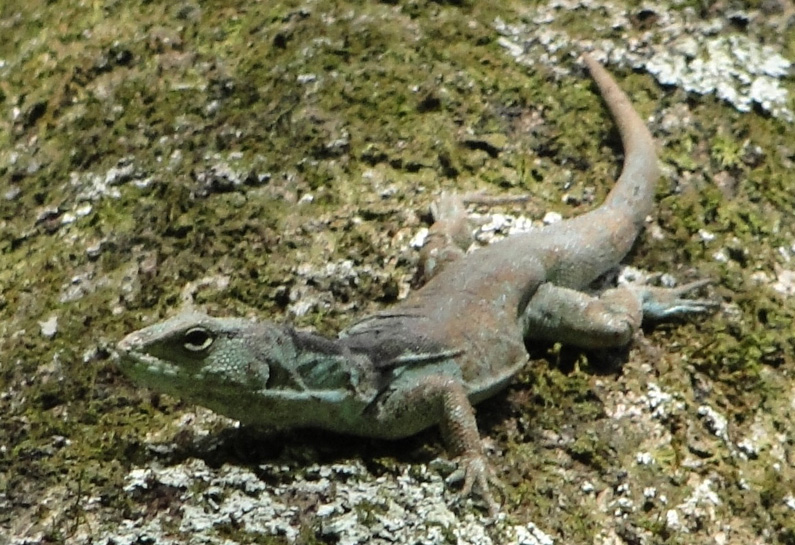Abstract
We describe a new species of Stenocercus from an interandean valley of the upper Río Huallaga on the Amazonian slope of central Peru (Región Huánuco), at an elevation of 1700–1900 m. The new species differs from other Stenocercus, except S. boettgeri, S. haenschi, S. humeralis, and S. varius, by the combination of the following characters: presence of granular scales on the posterior surface of the thighs, enlarged vertebrals, three caudal whorls per autotomic segment, a medially complete antegular fold, non-spinose caudals, and by males lacking a black transverse band on the ventral surface of the neck. However, the new Stenocercus differs from these, with the exception of S. humeralis, by having more scales around the midbody (104–107, =105.66) than S. boettgeri (79–104, Mean= 88.61), S. haenschi (57–64, Mean=60.50), and S. varius (74–88, Mean=82.35); and from S. humeralis by having the scales in the frontonasal region nearly equal in size to the scales in the occipitoparietal region, while in S. humeralis the scales on the frontonasal region are twice or three times longer than the scales on the occipitoparietal region.
References
Avila-Pires, T.C.S. (1995) Lizards of Brazilian Amazonia (Reptilia: Squamata). Nationaal Natuurhistorisch Museum, Zoologische Verhandelingen, 299, 1–706.
Brack, A. (1986) Las Ecoregiones del Perú. Boletín de Lima, 44, 57–70.
Cadle, J.E. (1991) Systematics of lizards of the genus Stenocercus (Iguania: Tropiduridae) from northern Peru: new species and comments on relationships and distribution patterns. Proceedings of the Academy of Natural Sciences of Philadelphia, 143, 1–96.
Cadle, J.E. (1998) New species of lizards, genus Stenocercus (Iguania: Tropiduridae), from western Ecuador and Peru. Bulletin of the Museum of Comparative Zoology, 155, 257–297.
Cadle, J.E. (2001) A new species of lizard related to Stenocercus caducus (Cope) (Squamata: Iguanidae) from Peru and Bolivia, with a key to the ‘‘Ophryoessoides Group.’’ Bulletin of the Museum of Comparative Zoology, 157, 183–222.
Campbell, J.A. & Lamar, W.W. (2004) The Venomous Reptiles of the Western Hemisphere, Volume I. Cornell University Press, Ithaca. 476pp.
Dumeril, A.M. & Bibron, G. (1837) Erpetologie Generale ou Histoire Naturelle Complete des Reptiles. Librairie Encyclopedique de Roret, Paris, France.
Lehr, E. (2002) Amphibien und Reptilien in Peru. Die Herpetofauna entlang des 10. Breitengrades von Peru: Arterfassung, Taxonomie, Okologische Bemerkungen und Biogeographische Beziehungen. Natur und Tier–Verlag, Munster, Germany.
Nogueira, C. & Rodrigues, M.T. (2006) The genus Stenocercus (Squamata: Tropiduridae) in extra-Amazonian Brazil, with the description of two new species. South American Journal of Herpetology, 1, 149–165. http://dx.doi.org/10.2994/1808-9798(2006)1[149:TGSSTI]2.0.CO;2
Peñaherrera del Aguila, C. (1989) Atlas del Perú. Instituto Geográfico Nacional, Lima, Perú.
Torres-Carvajal, O. (2000). Ecuadorian lizards of the genus Stenocercus (Squamata: Tropiduridae). Scientific Papers University of Kansas Museum of Natural History, 15, 1–38.
Torres-Carvajal, O. (2004). The abdominal skeleton of tropidurid lizards (Squamata: Tropiduridae). Herpetologica, 60, 75–83. http://dx.doi.org/10.1655/03-15
Torres-Carvajal, O. (2005a) A new species of iguanian lizard (Stenocercus) from the western lowlands of southern Ecuador and northern Peru. Herpetologica, 61, 78–85. http://dx.doi.org/10.1655/04-32.2
Torres-Carvajal O. (2005b) New Species of Stenocercus (Squamata: Iguania) from the Andes of Central Peru with a redescription of S. variabilis. Journal of Herpetology, 39(3), 471–477. http://dx.doi.org/10.1670/26-05A.1
Torres-Carvajal O. (2006) A new species of Stenocercus (Squamata, Iguania) from central-western Brazil with a key to Brazilian Stenocercus. Phyllomedusa, 4, 111–120.
Torres-Carvajal O. (2007a) Phylogeny and biogeography of a large radiation of Andean lizards (Iguania, Stenocercus). Zoologica Scripta, 36, 311–326. http://dx.doi.org/10.1111/j.1463-6409.2006.00284.x
Torres-Carvajal, O. (2007b) A taxonomic revision of South American Stenocercus (Squamata: Iguania) lizards. Herpetological Monographs, 21, 76–178. http://dx.doi.org/10.1655/06-001.1
Torres-Carvajal, O. (2007c) New Andean species of Stenocercus (Squamata: Iguania) from the eastern Cordillera in Colombia. Copeia, 2007, 56–61. http://dx.doi.org/10.1643/0045-8511(2007)7[56:NASOSS]2.0.CO;2
Torres-Carvajal O., Lehr E. & Lundberg M. (2005) Resurrection of Stenocercus torquatus Boulenger, a spiny-tailed iguanid lizard (Squamata: Iguania) from Peru. Herpetologica, 61(4), 440–448. http://dx.doi.org/10.1655/05-15.1
Torres-Carvajal, O., Schulte II, J.A & Cadle, J.E (2006) Phylogenetic relationships of South American lizards of the genus Stenocercus (Squamata: Iguania): a new approach using a general mixture model for gene sequence data. Molecular Phylogenetics and Evolution, 39, 171–185. http://dx.doi.org/10.1016/j.ympev.2005.09.007
Torres-Carvajal, O. & Carvajal-Campos, A. (2009) Reptilia, Squamata, Iguanidae, Stenocercus aculeatus: Distribution extension and first record for Ecuador. Check List, 5, 753–754.
Venegas, P.J., Echevarria, L.Y., Alvarez, S.C. & Vásquez, D. (2010) Reptilia, Squamata, Iguanidae, Stenocercus humeralis Gunther, 1859: First country record, Peru. Check List, 6(2), 250–202.

